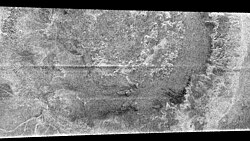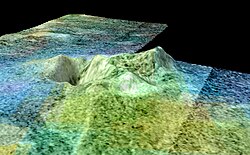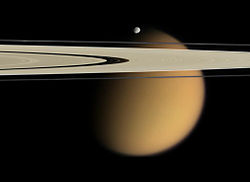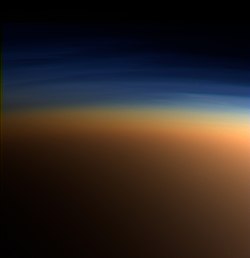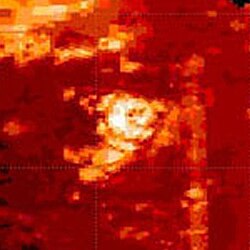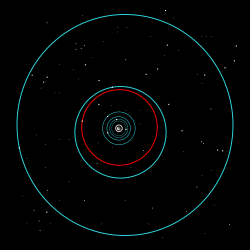PIA18430-SaturnMoon-Titan-EvolvingFeature-20140821
September 29, 2014
http://photojournal.jpl.nasa.gov/catalog/PIA18430
http://www.jpl.nasa.gov/news/news.php?release=2014-327
These three images, created from Cassini Synthetic Aperture Radar (SAR) data, show the appearance and evolution of a mysterious feature in Ligeia Mare, one of the largest hydrocarbon seas on Saturn's moon Titan. The views, taken during three different Cassini flybys of Titan, show that this feature was not visible in earlier radar images of the same region and its appearance changed between 2013 and 2014.
In the images, the dark areas represent the sea, which is thought to be composed of mostly methane and ethane. Most of the bright areas represent land surface above or just beneath the water line. The mysterious bright feature appears off the coast below center in the middle and right images.
The mystery feature had not been seen in preceding SAR observations of the region from 2007 to 2009. After its first appearance in early July 2013, it was not visible in observations by Cassini's Visible and Infrared Mapping Spectrometer, obtained later in July and in September 2013. Low-resolution SAR images obtained in October 2013 also failed to recover the feature.
The SAR observation from Cassini's August 21, 2014 Titan flyby shows that the feature was still visible, although its appearance changed during the 11 months since it was last observed. The feature seems to have changed in size between the images from 2013 and 2014 -- doubling from about 30 square miles (about 75 square kilometers) to about 60 square miles (about 160 square kilometers). Ongoing analyses of these data may eliminate some of the explanations previously put forward, or reveal new clues as to what is happening in Titan's seas.
The Cassini radar team is investigating possible origins for the feature, including surface waves, rising bubbles, floating solids, solids that are suspended just below the surface or perhaps something more exotic. Researchers suspect that the appearance of this feature could be related to changing seasons on Titan, as summer draws near in the moon's northern hemisphere. Monitoring such changes is a major goal for Cassini's current extended mission.
The upper half of the middle image uses data from the April 26, 2007 Titan flyby. That area did not receive SAR coverage during the July 10, 2013 encounter, so the earlier data was used to fill-in the scene.
The Cassini-Huygens mission is a cooperative project of NASA, the European Space Agency and the Italian Space Agency. NASA's Jet Propulsion Laboratory, a division of the California Institute of Technology in Pasadena, manages the mission for NASA's Science Mission Directorate, Washington, DC. The Cassini orbiter was designed, developed and assembled at JPL. The radar instrument was built by JPL and the Italian Space Agency, working with team members from the United States and several European countries.Relevantní obrázky
Relevantní články
Ligeia MareLigeia Mare je moře na Saturnově měsíci Titanu nacházející se na severní polokouli. Je to druhé největší těleso tvořené kapalinou na povrchu Titanu, hned po Kraken Mare. Rozlohou je větší než Hořejší jezero na Zemi a většinově se skládá z tekutého metanu s malou příměsí dusíku, etanu a dalších organických sloučenin. Nachází se na souřadnicích 78° N, -249° W a bylo plně zmapováno sondou Cassini. Je 420 km dlouhé, 350 km široké, zabírá plochu zhruba 126 tisíc kilometrů čtverečních a jeho pobřeží je dlouhé přes 2 tisíce kilometrů. Moře může být hydrologicky spojené s větším Kraken Mare. Jeho jméno je Ligeia podle jedné ze sirén z řecké mytologie. .. pokračovat ve čtení
Titan (měsíc)Titan je největší ze 145 do května 2023 objevených měsíců planety Saturn. Je jediným měsícem sluneční soustavy, u něhož byla objevena silná atmosféra, a kromě Země je jediným objektem ve vesmíru, u něhož byla s jistotou ověřena přítomnost stálých kapalných struktur na jeho povrchu. .. pokračovat ve čtení









